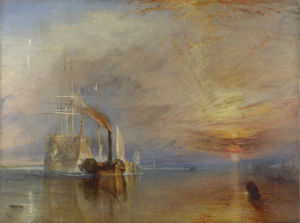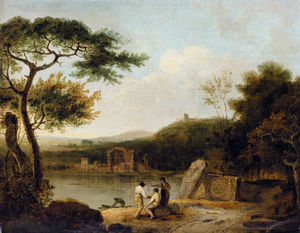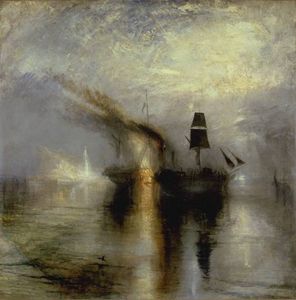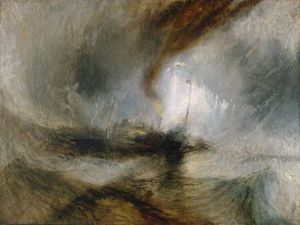The Fighting Temeraire
- Date of Creation:
- 1839
- Alternative Names:
- The Fighting Temeraire tugged to her last berth to be broken up
- Height (cm):
- 90.70
- Length (cm):
- 121.60
- Medium:
- Oil
- Support:
- Canvas
- Subject:
- Landscapes
- Framed:
- No
- Art Movement:
- Romanticism
- Created by:
- Current Location:
- London, United Kingdom
- Displayed at:
- National Gallery London
- Owner:
- National Gallery London
- The Fighting Temeraire Page's Content
- Story / Theme
- Inspirations for the Work
- Analysis
- Critical Reception
- Related Paintings
- Locations Through Time - Notable Sales
- Artist
- Art Period
- Bibliography
The Fighting Temeraire Story / Theme
The Temeraire had a dramatic and victorious career in her more useful days. She earned her legendary place in British naval history after coming to the aid of fellow British ship, the Victory, during the important Battle of Trafalgar in 1805. Napoleon, along with his newly acquired French and Spanish fleets, raged an invasion against Britain.
It was the morning of October 21st, 1805. The Franco-Spanish fleet had 33 ships, the British only 22. Fortunately, among the 22 was the 98-gun Temeraire. British Captain Nelson arranged his fleet into two columns to attack the enemy head on. His ship, Victory, went straight through the line but not without absorbing significant damage. They hadn't even opened fired yet. Recovering from the blow, they managed to take down a French flagship, the Bucentaure.
Victory's further progress however was blocked by the French Redoutable. Coming to the rescue, the Temeraire thwarted the enemy ship from the opposite side. The Victory and Temeraire defeated Napoleon's forces with combined tactics. Eventually it was the Temeraire that ultimately lead Britain to victory. Though many of Britain's men were killed in this battle, Britain was not without triumph. The Battle of Trafalgar allowed the expansion of British colonial power for many years, keeping Napoleon out for good.
Turner wanted to give credit where credit was due. He desired to admire the glorious and passing age of the sail ship, replaced by the new age of steam and steel. He sought to evoke a sense of loss, and focused more on that quality than portraying complete accuracy. In reality it was said that the Temeraire was pulled by two tugs, not one. The scene was also without the beautiful sunset Turner afforded viewers. Once again, Turner took the liberty to romanticize a scene very close to his heart.
In The Fighting Temeraire the enchanting old war ship towers over the new steam power tug, a vessel that lacks personality and the story that the 'Fighting Temeraire' does. She is being tugged by this new ship, ultimately to her death. She will soon be broken up for scraps.
The Fighting Temeraire Inspirations for the Work
Turner's great fascination and admiration for the 98-gun ship, the Temeraire, and her valiant battle story inspired this painting. The Temeraire played a key role in England's victory in the 1805 Battle of Trafalgar against Napoleon forces. Her determined efforts earned her the name, "Fighting Temeraire. "
Thirty-three years after her glorious days, she was to be forgotten and broken up for scrap parts after being replaced by the modern steamboat. Turner sought to record this sad account in his painting, The Fighting Temeraire tugged to her last berth to be broken up.
Fellow landscapist Richard Wilson provided early inspiration for Turner's landscapes. Though he developed his own unique style, traces of Wilson's influence can be seen in The Fighting Temeraire.
The Fighting Temeraire Analysis
In true Turner style, the wonderful composition of The Fighting Temeraire was played out by his warm color palette. His use of colors served to create another fantastic sunset and sky scene. The tone of his favorite piece pays tribute to England's beloved Temeraire, showing her glory even on her way to be broken into scraps.
Composition:
As this canvas is mostly devoid of objects, save the two sea vessels, Turner uses color to dictate the composition of this piece. The main subjects, the Temeraire and the tugboat that pulls her to her death, are enveloped in a triangle of blue.
That this color contrasts against the mostly warm palette, attention is drawn directly to the two floating objects. The sun sets on the right side, adjacent to the ships as a pleasant afterthought when the eye retreats from the ships.
Tone:
Turner intended to invoke a nostalgic and somber response from the viewer. The Temeraire was a vessel close to the heart of the artist, and as it is tugged to its untimely death (replaced by modern steam vessels) Turner paints with reflection and admiration; the Temeraire sails proudly, still valiant, on her way to be broken into scrap parts.
Brush strokes:
The effectiveness of the lighting in this piece was achieved through Turner's light and loose brush stroke. Had he practiced a tighter, more precise stroke the atmosphere wouldn't have been so elusive and hazy.
Color Palette:
Turner's palette, save the blue triangle behind the ships, is predominantly warm. He chooses his colors wisely, in an effort to evoke a tribute to the beloved Temeraire. Though the colors he paints with are warm, the nostalgic notion is still apparent in this scene. The luminous whites of the sky demand attention, as do the bright yellows of the setting sun.
Lighting:
As this was one of his later paintings, Turner focused almost entirely on the lighting of this piece. He wanted the atmosphere to dominate, to evoke the feeling he felt during this scene.
The Fighting Temeraire Critical Reception
The Fighting Temeraire is considered by both the general public and by Turner himself to be one of his greatest paintings. It has received a fair amount of positive attention from its first exhibit to the Royal Academy in 1837 up until now. As it is a classic, with an unforgettable landscape and very popular subject matter, it will most likely continue to be greatly admired for years to come.
Contemporary Reception:
As some of Turner's paintings went largely misunderstood by those of his time, The Fighting Temeraire was considered one of his greatest works by his modern day critics. He happened to agree with them, his "darling" was a painting he could not part with for any sum of money. It was later willed to the National Gallery after his death.
The Morning Chronicle of May 7th, 1839 speaks of the painting representing "the decay of a noble human being. " They continue on, "the gorgeous horizon poetically intimates that the sun of the Temeraire is setting in glory. " The Literary Gazette wrote four days later that "the sun of the glorious vessel... setting in a flood of light... typifying the departing glories of the old Temeraire."
More papers continued to admire the painting which would receive even wider recognition a few years later, once again thanks to friend and art critic, John Ruskin.
It has been suggested by 20th century critics, that perhaps it was the subject that the viewers liked, more than the actual painting.
Posthumous Reception:
Turner work as a whole was admired greatly by the impressionist artists. They studied and followed his later works very closely.
Modern Day Reception:
The Fighting Temeraire is viewed very positively in the present time. In fact, it was voted the "greatest painting in Britain" in a 2005 in a poll held by the National Gallery and the BBC Radio. The British public cast the votes and Turner's famous painting received the greatest attention with 31,892 votes out of 118,111.
The Fighting Temeraire Related Paintings
The Fighting Temeraire Locations Through Time - Notable Sales
As this was one of his favorite paintings, Turner could not part with it. It was exhibited at the Royal Academy in 1838 and remained in Turner's possession until it was bequeathed to the nation of Britain by Turner in 1851. It currently hangs in The National Gallery, London.
The Fighting Temeraire Artist
J. M.W. Turner began his artistic career at a very young age. His success was fairly immediate, selling his first painting at just 12 years old. He continued to accomplish significant achievements at a remarkably young age and throughout his career he remained highly sought-after and acquired a very large fortune from his commissions.
He is remembered as an influential painter, said to be the best landscapist of the 19th century, and a key artist to influence the Impressionist movement. Turner is famed for his original interpretations of bringing light and color to his canvases.
Turner painted The Fighting Temeraire when he was 63-years-old. By this age, he began to break away from the classical traditions he developed while at the Royal Academy. His art began to take on a looser form, paving the way for Impressionism.
This was the second of four steam boat paintings completed by Turner. When he enjoyed a subject, he revisited it many times. The Fighting Temeraire is considered by both the general public and by Turner himself to be one of his greatest paintings.
The Fighting Temeraire Art Period
Romanticism is sometimes viewed as a reaction to its more serious predecessor, the Neoclassical movement. As Neoclassical artists focused on properly accounting history through a close attention to detail, Romantic artists flirted with themes of man's self glorification, man's part in nature, divinity found in nature, and emotion.
Though neoclassicism is generally associated with the history genre, Turner is credited with having embarked upon a subject matter so great that it actually rivaled the history genre. His subject matter accounts for recording history, but in a different style than ever seen before. He used color as an intensity of emotion to portray the passing of events.
The Fighting Temeraire Bibliography
You can find out more about this, and Turner's other works be referring to the books listed below.
Books:
• Brennan, Matthew. Wordsworth, Turner, and Romantic Landscape. Columbia, SC. : Camden House, 1987
• Gage, John. Color in Turner: Poetry and Truth. New York: Frederick A. Praeger, 1969
• Gaunt, William. Turner. Oxford: Phaidon Press, 1971
Recommended Readings:
• Lindsay, Jack. J. M. W. Turner: A Critical Biography. London: Cory, Adams and Mackay, 1966
• Turner, J. M. W. The Shipwreck. 1805












